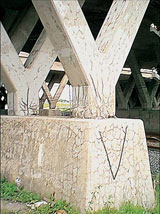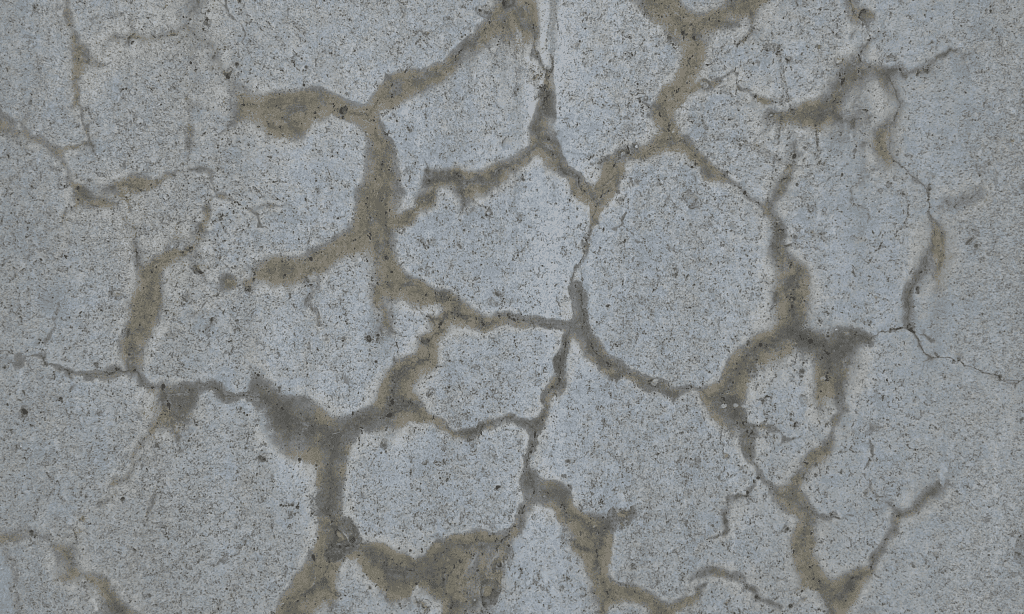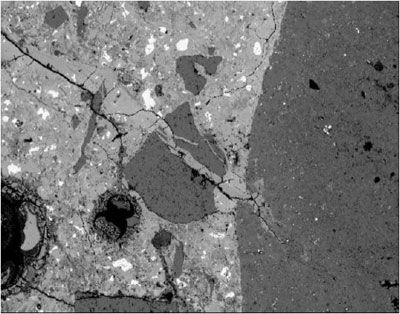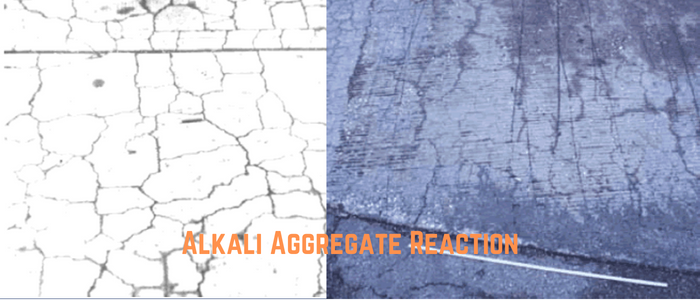In this post, we will talk about a damage that happens to concrete and this damage is not mainly due to the detrimental materials in the environment. But, this damage is due to using materials that are not with good quality for concrete production. The damage mechanism is alkali aggregate reaction in concrete (abbreviated as AAR) and the inner material that is of concern is the aggregates.
So, What is Alkali Aggregate Reaction?
Types/Categories of Alkali Aggregate Reaction
There are two types for the alkali aggregate reaction:
- Alkali-silica reaction (ASR)
- Alkali-carbonate reaction (ACR)
Alkali Silica Reaction ( abbreviated as ASR)
In this type of reaction, the chemical reaction is happening between the alkalies and certain siliceous rocks or minerals, such opaline chert, strained quartz, and acidic volcanic glass.
This is the most commonly type that has high potential to happen because aggregates with siliceous materials exist more frequently in nature. Thus, ASR is of more concern compared to ACR.
So, what happens is that the siliceous materials in aggregates will react with the alkalies in cement (usually alkalies exist in the form of hydroxides such as sodium and potassium hydroxide) to form a silica gel that swells as it adsorbs water from the surrounding cement paste or the environment. These gels have the ability to cause concrete damage with their expanding pressure.
Cracking starts in places that get moisture often, such as in piers near the coastline, behind retaining walls close to the earth, or in piers or columns that are vulnerable to wicking activity. However, note that the damages occurs in these area if the aggregate is reactive. If the aggregate does not contain reactive materials (such as reactive silica), no AAR will happen.

How does Alkali Silica Reaction Damage Look Like?
The damage of ASR appears in the form of random map cracking and, in advanced cases, closed joints and spalling of concrete pieces for the element.

How to Identify ASR?
There are kits that can be used to identify alkali-silica reactions. Kits usually consist of two reagents that are applied to the broken surface of a concrete core and the excess rinsed off. On contaminated concrete, the resultant stains reveal the presence of ASR.
To conclusively identify ASR, petrographic examination is to be used. Petrographic testing is the use of microscopes to examine samples of concrete to determine their mineralogical and chemical characteristics.

How to Control ASR?
Certain additional cementitious materials can be used to limit the alkali-silica reaction.
The expansion caused by alkali-silica reactivity has been greatly decreased or minimized when silica fume, fly ash, and ground granulated blast-furnace slag have been used in the appropriate proportions.
Lithium compounds have also been employed to lessen ASR.
Alkali Carbonate Reaction ( abbreviated as ACR)
In this type of reaction, the chemical reaction is happening between the alkalies and certain carbonate rocks, particularly calcitic dolomite and dolomitic limestones, present in some aggregates.
This type does not occur frequently because aggregates that have active carbonates to react with the alkalies occur less naturally.
The deterioration caused by alkali-carbonate reactions is similar to that caused by ASR; ACR is nonetheless a rather uncommon occurrence due to the rarity of this occurrence and the general unsuitability of susceptible aggregates for concrete application.
So, what happens is that the carbonates in aggregates will react with the alkalies in cement to form swelling materials that expand and cause damage.
Alkali from the cement might react with the dolomite crystals present in the aggregate inducing the production of brucite, (MgOH)2, and calcite (CaCO3). This reaction and subsequent crystallization of brucite may cause considerable expansion.
How does Alkali Carbonate Reaction Damage Look Like?
The damage of ACR appears is similar to ASR in shape.
How to Identify ACR?
There are kits that can be used to identify alkali-carbonate reactions. Kits usually consist of two reagents that are applied to the broken surface of a concrete core and the excess rinsed off. On contaminated concrete, the resultant stains reveal the presence of ACR.
To conclusively identify ACR, petrographic examination is to be used. Petrographic testing is the use of microscopes to examine samples of concrete to determine their mineralogical and chemical characteristics.
Aggregates susceptible to ACR tend to have a characteristic texture that can be identified by petrographers.
How to Control ACR?
Contrary to alkali silica reaction, the introduction of supplementary cementing materials does not stop harmful expansion brought on by ACR.
Therefore, we recommend the exclusion of ACR susceptible aggregates from use in concrete.
Based on what we discussed previously, let us mention the resulting actions from AAR and conditions that are required for alkali aggregate reaction to occur.
Effects of Alkali-Aggregate Reaction
We mentioned that cracks eventually develop due to AAR. What else can happen?
- Loss of strength and stiffness of the concrete element.
- Higher permeability which of course assist in further ingress of detrimental materials.
- Less concrete durability
- Appearance is not good.
- High repair and maintenance cost.
- Premature failure of the concrete elements and less service life.
Conditions Necessary for Alkali Aggregate Reaction
Three components need to exist to AAR to happen. They are:
- The presence of reactive materials in the used aggregates (either silica or carbonates).
- The presence of high alkalies content in concrete.
- The presence of enough moisture for reaction and expansion to continue.
Up to these point, we mainly discussed the reactive materials in the aggregate. But how about the alkalies? where are they coming from?
Where are Alkalies coming from?
- Cement is the major source of alkalies in concrete.
- Alkali in concrete may be released by aggregate containing feldspar, some mica, glass, and glassy rock. If sea dredging sand is not thoroughly washed, sodium chloride may be present, which can significantly add alkali to concrete.
- Admixtures such as accelerators, water reducers (plasticizers), retarders, superplasticizers, air-entraining, etc. contain sodium and potassium compounds.
- Mixing water may contain a certain amount of alkalies.
- External sources: De-icing salt, which contains sodium compounds, may raise the alkali content of concrete’s top layer in cold-weather regions. Alkali-rich soils may also increase the amount of alkali on the surface of concrete.
ASTM Testing for Alkali Aggregate Reaction
- Petrographic Examination (ASTM C 295)
- Chemical Test (ASTM C289)
- Accelerated Mortar Bar Test (ASTM C 1260)
- Concrete Prism Test (ASTM C1293)
Preventive Measures against AAR
To prevent AAR, focus how to prevent the conditions necessary for AAR to occur:
- Reduce the amount of alkalies in concrete by using low-alkali cement. It is demonstrated that damage expansion due to AAR is unlikely to occur when the overall alkali concentration, measured in equivalent sodium oxide, is less than 3 kg/m3, given that known strongly alkali-reactive materials, including opal and glass, are not included in the concrete.
- Using cementitious replacement materials in concrete, such as PFA and GGBS, can reduce the amount of alkalies in the mix.
- Keep the concrete properly dry and limit the entrance of moisture by decreasing the permeability of concrete.
- Avoid using reactive aggregate; if you must, take the required safety measures to guard against the effects of alkali-aggregate reactions.
- Use lithium salts, for example, to alter any gel’s characteristics such that they become non-expansive.
Read Also:

